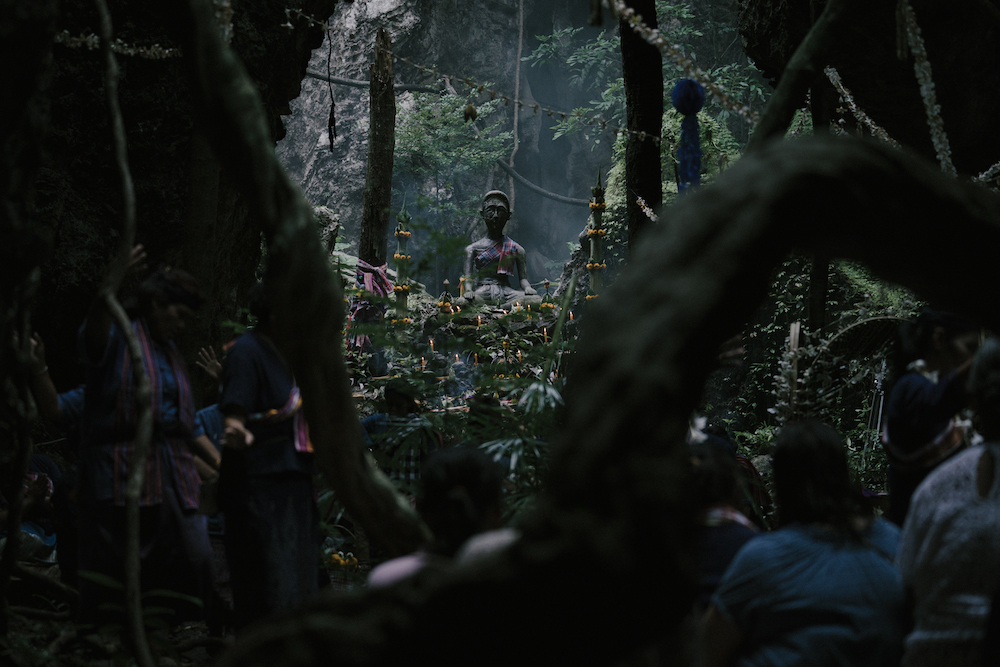This review contains spoilers for ’The Medium’.
Horror works best when it’s left up to the imagination. Show the viewers the eerie movements and uncanny contortions of possessed victims, litter scenes with macabre objects and animal corpses, and linger on shots that show how an everyday item is a little, well, off. That’s the recipe for Thai-Korean horror film The Medium, directed by Shutter’s Banjong Pisanthanakun and produced by The Wailing’s Na Hong-jin.
Framed as a documentary about shamanistic practices in northern Thailand’s Isan area, The Medium employs a fly-on-the-wall shooting style to lend a sense of authenticity to the events depicted, which further intensifies the horror and terror of the movie. I do advice viewers inflicted with chronic vertigo or migraine to exercise due caution—some of the camera shots can get incredibly janky.
The Medium begins fairly innocuously (as much as a horror movie can) as a film crew documents the everyday life of Nim (Sawanee Utoomma), a shaman of the goddess Ba Yan. The travel documentary aspect of the film lulls you into a false sense of security as you experience what life is like for the villagers and Nim. Foreign films are our only window to travel during this pandemic, so even if it were indeed a documentary about the shamanistic practices of the rural areas of Thailand, it would still be an effective one.
For all accounts and purposes, Nim leads a fairly idyllic life, albeit one filled with mysticism and rituals. But all that is upturned when she has to return home and help her sister Noi (Sirani Yankittikan) and niece Mink (Narilya Gulmongkolpech).
And yes, there is family drama (is there really any better type?) when the family’s legacy is unearthed concerning the inheritance of Ba Yan’s shamans. Here’s when Mink starts exhibiting classic tell-tale signs of becoming the next shaman of Ba Yan and is also where things start going horribly wrong for the family.

With The Medium, horror exists in the small things—a quiet invocation here, a superstitious nod there. Unlike Western horror films, where the supernatural lives in its own discrete realm, the tacit understanding in The Medium that we live in a world of unseen spirits makes it all the more relatable—and terrifying when the scares hit. Even the director noted the similarities between the shamanistic practices in Asian countries, showing how ingrained this is in Asian culture.
Once the movie goes into full swing, however, Mink’s possessions are violent, gory, and unnerving. Thanks to the handheld camera, we don’t always get a clear shot of what she’s doing, creating this sense of helplessness. As more victims get possessed, the film builds to a terrifying crescendo—all without ever showing us what exactly is possessing all these people. The camera lingers shakily on the characters’ backs, making us wonder what is happening to them as we slowly inch towards yet another victim.
It was foreboding enough that when the usher suddenly popped up to do mask checks in the cinema (good on you, Golden Village!), I let out a soft shriek. For the avoidance of all doubt, I was wearing my mask properly, but the folk three rows in front of me weren’t. Tsk tsk.
As with all such documentary-style horror movies, there are scenes in The Medium when the night vision mode in the camera is turned on, and others that capture the perspective of CCTVs installed in the victim’s house. If I were to point out the eeriest parts of this movie, the six documented nights leading up to Mink’s spiritual cleansing would easily fit the bill.
Every second that the screen is lit by the characteristic green glow of a night vision camera becomes an exercise in unhinged terror. The cameras capture Mink first under the stairs and then hovering over her mother as if ready for a lip-smackingly tasty midnight snack. By the fourth night, I was quite done. On the third, I was all packed up and ready to leave.
But even before the more blatant frights, The Medium manages to unbalance and unseat you with skilful juxtapositions of the supernatural and the ordinary. Mink goes into fits of violence while on a celebratory parade, and when she goes missing, the villagers search for her desperately as a beautiful tapestry of fireworks go off in the sky. It’s disconcerting and subtly wears you down for the terror that is about to follow.
The film’s grand finale does go a little overboard, however, as it goes into full-on The Ring-Ju-on-Shutter horror mode. For a movie that’s been primarily subtle about its scares, the last Act is, in a word, excessive. That’s not to say it isn’t scary because it’s so terrifying that I had to look away from the screen several times (the usher was no longer around). It keeps you at the edge of your seat without ever relenting, gripping your attention tight within its grasp with no signs of letting up. Ever.
As a scriptwriter, I appreciated the film’s closing scene—an “interview” with Nim. For anyone who’s been deeply religious, her reflections on her doubt and her faith cut deep to the bone. Given how many are turning away from religion in recent years, this seemed a particularly relevant and contemporary issue to have been raised, albeit for just a short scene. It added an extra dimension to Nim’s characterisation and her actions and shed new light on her actions in the movie.
The Medium’s style, drama, and setting make for an absolutely horrifying movie that shocks and unnerves. There’s blood, incest, ritualistic practices, night vision cameras, animal sacrifice—all ingredients that make for a film that fully intends to keep you up at night for the next few days.
It emerges as a fresh contender in a space that’s been chiefly inundated with Western horror movies. I say it’s time for Asia to reclaim its golden days of horror, and The Medium may very well pave the way for that.







